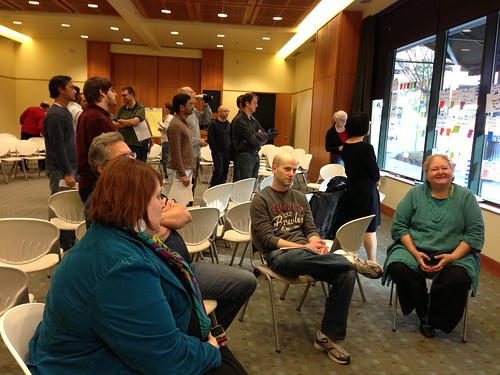Seattle Lean Camp
Monday, July 13th, 2015This summer I’ve been involved with two conferences about Agile and Lean. One was Agile2011, a huge, five-day conference in Salt Lake City. The other was Seattle Lean Camp, a small two-day event at the Center for Urban Horticulture in Seattle (sponsored by Getty Images, Nordstrom Innovation Lab, Modus Cooperandi, and University of Washington Bothell).
At Agile2011, I presented at two sessions, “Intro to Test-Driven Development and Pair Programming Dojo” and “Agile Isn’t Enough”; they went well and I’ll write more about them later.
For Seattle Lean Camp, I was both the Open Space Facilitator and a conference co-creator, along with Person Kanban author, Jim Benson.
Both conferences were aimed at professionals in software development and information management. But while Agile 2011 used a traditional conference structure, the lean camp used Open Space Technology, a structure we hoped would enable participants to experience some Agile and Lean techniques as well as studying and discussing them.
How did this go? Here are a few of my observations about Lean Camp:
- Jim and I were astonished by the turnout. Not just by the numbers (130 people), but by the breadth and diversity of the attendees. We had leaders in the field, newcomers, and participants who flew in all the way from D.C. and L.A.
- About half of our participants were people who had already worked with Agile/Lean and who wanted to be involved in networking and spreading the word. The other half had heard about it but had never seen it in action.
- The Open Space Technology conference model did what it was supposed to do: Enabled attendees to focus on the topics they wanted to discuss. Of course, there were surprises. Owen Harrison, who’s credited with inventing the Open Space conference, said that he’s still surprised every time he leads one.
- I’ve been a participant in many Open Space events, but it was different being a facilitator. Even weird. It was fascinating to watch as the “marketplace” filled up with sessions. My job was simple to “hold the space” so attendees could make it all happen.
- Looking back on the conference, my sense was that we could have prepared people better for taking advantage of Open Space. For some, it was an adjustment to realize that the agenda would be developed n a participatory fashion, on the spot.
- One great surprise of the conference was lunch, and the lunch system. It was really different, and worked surprisingly well. We had Seattle lunch trucks come each day for three hours. To prevent lines and waiting, Jim used a Kanban system in which there were distributed lunchtimes and people assigned themselves to a lunch session.
- At the end of the first day we did a quick feedback session that we applied to the next day. It included Virginia Satir’s sequence of appreciations, hopes and wishes, and complaints with recommendations. We made a starfish diagram for the next day, with lists of what we should stop, start, do less of, do more of, or keep just the same way.
You can get a sense of the conference from the website, and by taking a look at the proceedings. Each session used easels with flipcharts and sticky notes to create their own notes. We later photographed the flipcharts from each session and uploaded the pictures to Flickr — instant proceedings! You’re more than welcome to take a look.




